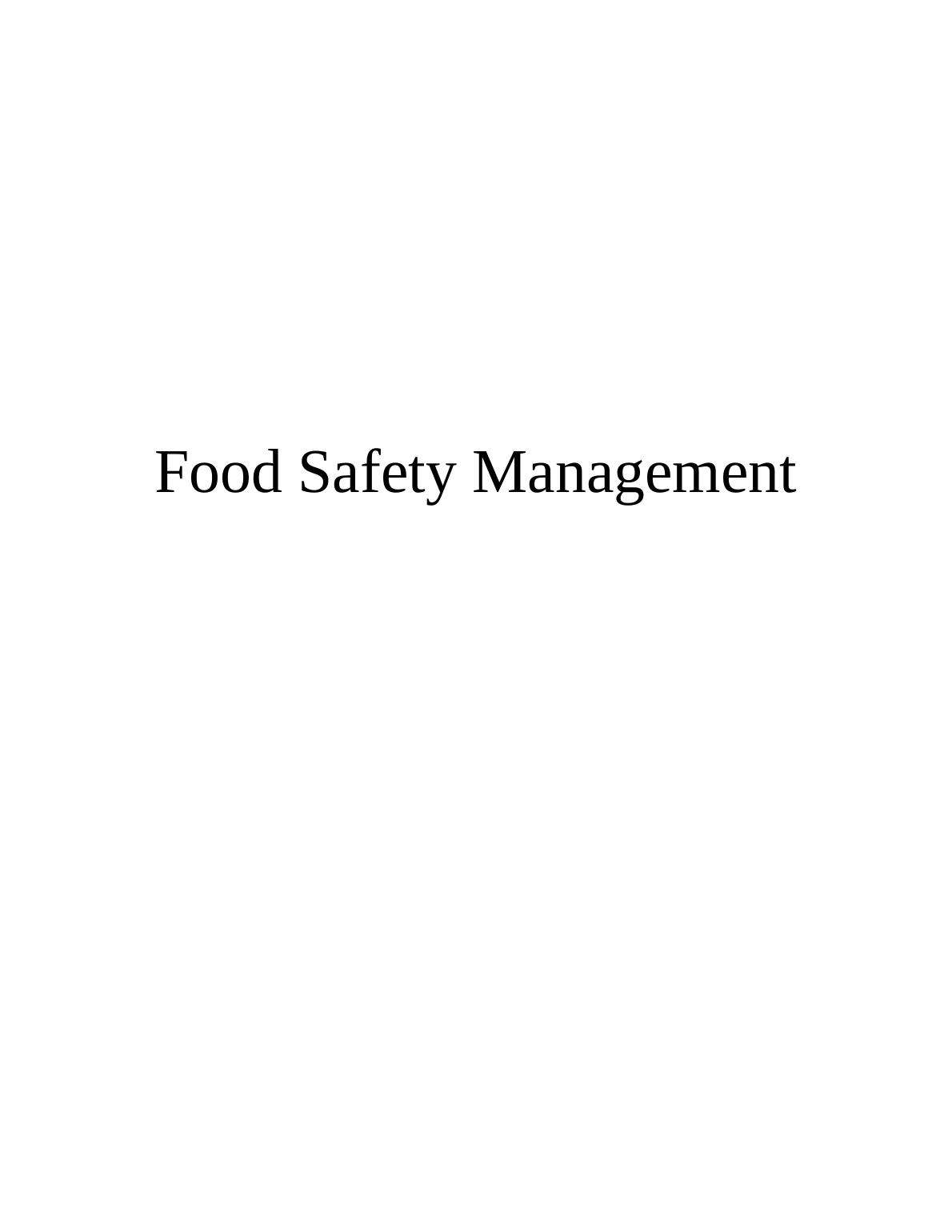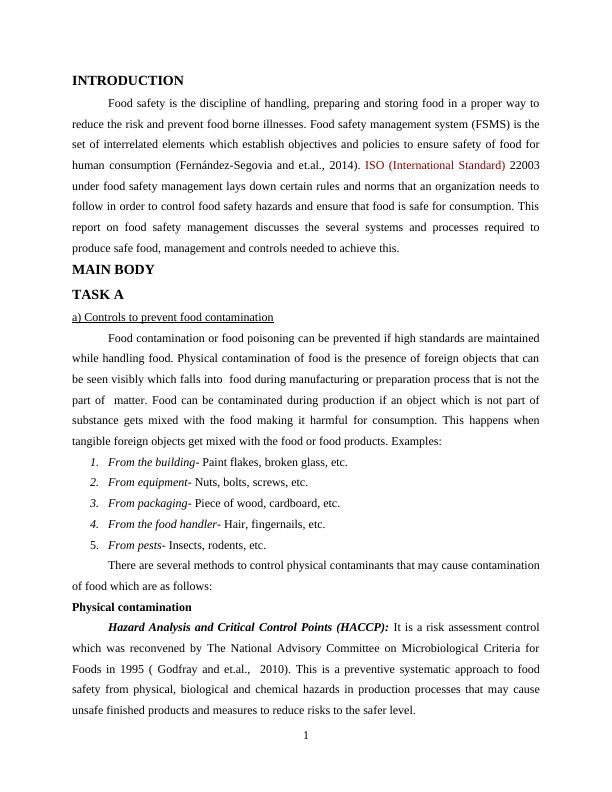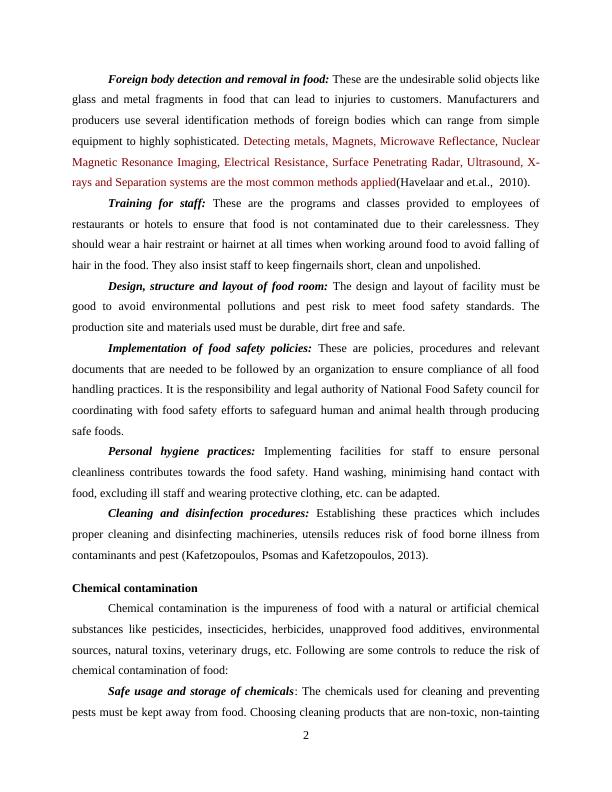(Doc) Food Safety Management Assignment Solution
12 Pages3629 Words362 Views
Added on 2020-10-22
(Doc) Food Safety Management Assignment Solution
Added on 2020-10-22
ShareRelated Documents
Food Safety Management


INTRODUCTIONFood safety is the discipline of handling, preparing and storing food in a proper way toreduce the risk and prevent food borne illnesses. Food safety management system (FSMS) is theset of interrelated elements which establish objectives and policies to ensure safety of food forhuman consumption (Fernández-Segovia and et.al., 2014). ISO (International Standard) 22003under food safety management lays down certain rules and norms that an organization needs tofollow in order to control food safety hazards and ensure that food is safe for consumption. Thisreport on food safety management discusses the several systems and processes required toproduce safe food, management and controls needed to achieve this. MAIN BODYTASK Aa) Controls to prevent food contaminationFood contamination or food poisoning can be prevented if high standards are maintainedwhile handling food. Physical contamination of food is the presence of foreign objects that canbe seen visibly which falls into food during manufacturing or preparation process that is not thepart of matter. Food can be contaminated during production if an object which is not part ofsubstance gets mixed with the food making it harmful for consumption. This happens whentangible foreign objects get mixed with the food or food products. Examples:1.From the building- Paint flakes, broken glass, etc.2.From equipment- Nuts, bolts, screws, etc.3.From packaging- Piece of wood, cardboard, etc.4.From the food handler- Hair, fingernails, etc.5.From pests- Insects, rodents, etc.There are several methods to control physical contaminants that may cause contaminationof food which are as follows:Physical contaminationHazard Analysis and Critical Control Points (HACCP): It is a risk assessment controlwhich was reconvened by The National Advisory Committee on Microbiological Criteria forFoods in 1995 ( Godfray and et.al., 2010). This is a preventive systematic approach to foodsafety from physical, biological and chemical hazards in production processes that may causeunsafe finished products and measures to reduce risks to the safer level. 1

Foreign body detection and removal in food: These are the undesirable solid objects likeglass and metal fragments in food that can lead to injuries to customers. Manufacturers andproducers use several identification methods of foreign bodies which can range from simpleequipment to highly sophisticated. Detecting metals, Magnets, Microwave Reflectance, NuclearMagnetic Resonance Imaging, Electrical Resistance, Surface Penetrating Radar, Ultrasound, X-rays and Separation systems are the most common methods applied(Havelaar and et.al., 2010).Training for staff: These are the programs and classes provided to employees ofrestaurants or hotels to ensure that food is not contaminated due to their carelessness. Theyshould wear a hair restraint or hairnet at all times when working around food to avoid falling ofhair in the food. They also insist staff to keep fingernails short, clean and unpolished. Design, structure and layout of food room: The design and layout of facility must begood to avoid environmental pollutions and pest risk to meet food safety standards. Theproduction site and materials used must be durable, dirt free and safe.Implementation of food safety policies: These are policies, procedures and relevantdocuments that are needed to be followed by an organization to ensure compliance of all foodhandling practices. It is the responsibility and legal authority of National Food Safety council forcoordinating with food safety efforts to safeguard human and animal health through producingsafe foods.Personal hygiene practices: Implementing facilities for staff to ensure personalcleanliness contributes towards the food safety. Hand washing, minimising hand contact withfood, excluding ill staff and wearing protective clothing, etc. can be adapted.Cleaning and disinfection procedures: Establishing these practices which includesproper cleaning and disinfecting machineries, utensils reduces risk of food borne illness fromcontaminants and pest (Kafetzopoulos, Psomas and Kafetzopoulos, 2013).Chemical contaminationChemical contamination is the impureness of food with a natural or artificial chemicalsubstances like pesticides, insecticides, herbicides, unapproved food additives, environmentalsources, natural toxins, veterinary drugs, etc. Following are some controls to reduce the risk ofchemical contamination of food:Safe usage and storage of chemicals: The chemicals used for cleaning and preventingpests must be kept away from food. Choosing cleaning products that are non-toxic, non-tainting2

End of preview
Want to access all the pages? Upload your documents or become a member.
Related Documents
Food Safety Management: Controls to Prevent Contamination, Characteristics of Food Poisoning and Food Borne Infections, and How to Control Food-Borne Illnesseslg...
|22
|916
|27
Food Safety and Management System - PDFlg...
|14
|3891
|253
Food Safety Managementlg...
|20
|1476
|72
Food Safety Managementlg...
|20
|1102
|86
Food Safety Management Doclg...
|15
|4023
|182
Food Safety Management - Assignmentlg...
|13
|3257
|64
